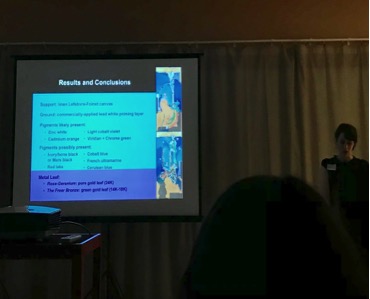Speaker: Keara Teeter, Graduate Fellow, WUDPAC Class of 2019
Talk Title: “Technical Examination of Two (of the Seven) Edward Steichen In Exaltation of Flowers Murals Painted Between 1910-1914”

Generally known for his contribution in photography, Edward Steichen created seven murals of tempera and gold leaf; five measuring approximately 10 x 4-1/2 feet, and two measuring 10 x 8 feet. These murals vibrantly portray certain individuals in Steichen’s social circle along with flowers that could have been observed in his personal garden. Two of these murals (Rose-Geranium and Petunia-Begonia-The Freer Bronze) were highlighted in WCG’s 3-Ring Circus on the night of January 10 by Keara Teeter, a graduate fellow at Winterthur/University of Delaware Program in Art Conservation (WUDPAC). Keara performed treatment on Flowers in 2017 at the Dallas Museum of Art and conducted extensive technical research between 2017-2018 at the Winterthur Museum—see UDaily to learn more about the internship. Attendees of the WCG lecture learned of not only the composition of the materials, but their comparisons, differences, and even a connection to Salvador Dali—Dali’s Figure and Drapery in a Landscape (1935) share the same canvas maker as Steichen’s murals[1].Technical analysis was the basis of the presentation as various techniques were needed to identify the pigments and fiber(s) used in Flowers. FTIR (Fourier-transform infrared spectroscopy), XRF (X-ray fluorescence), and GC-MS (gas chromatography mass spectrometry) were among some of the studies performed. These analyses concluded the presence of linen fiber, linseed oil binder, commercially-applied lead white ground, and zinc white as a key pigment used in the paintings. Another key material, gold, was present in the metal leaf of both Rose-Geranium and Petunia-Begonia-The Freer Bronze; elemental gold and silver were detected in metal leaf from only one of the paintings—The Freer Bronze. Keara also noted the lack of protein detected during her technical analysis. Future research is needed to shed additional light on the presence or absence of a protein binder as well as to analyze “the composition of the priming layer underneath the metal leaf.” With such a large yet relatively unknown work from the artist, it’s no wonder many technical studies were and still are needed to cover the gamut of the murals.
Summary by Tiffany Greene, Pre-program student/intern
[1] Dali and Steichen’s canvases both have a “Lucien Lefebvre-Foinet” colorman stamp.